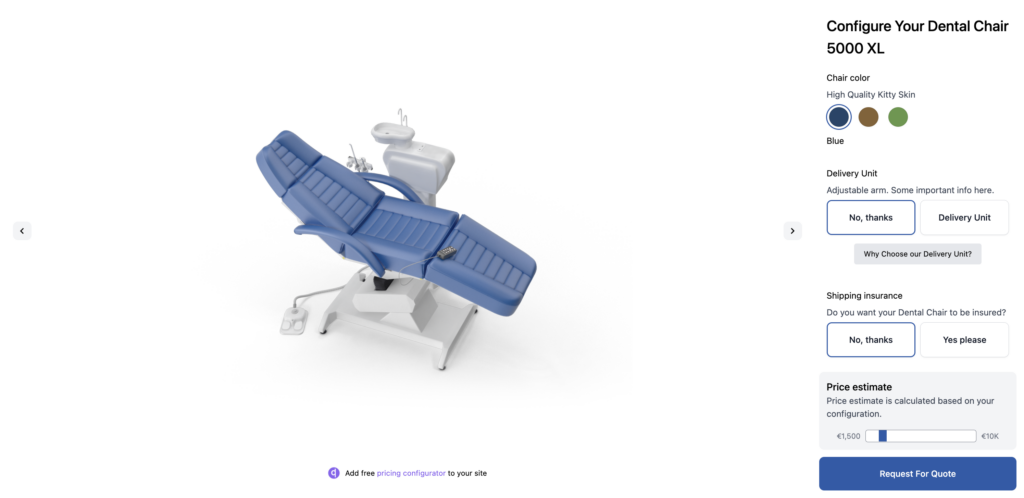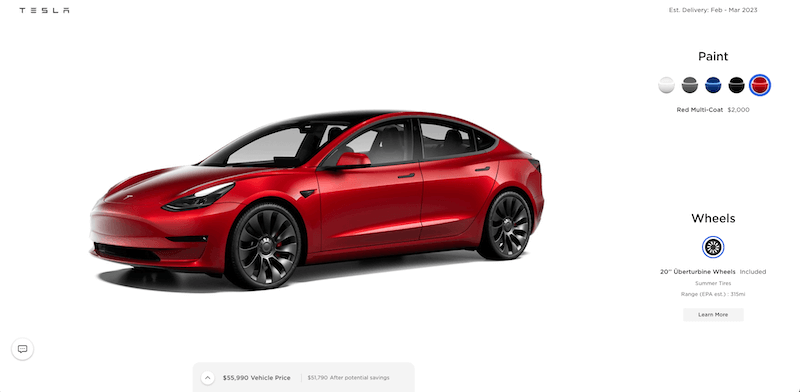Introduction: The Complexity Conundrum
When it comes to B2B eCommerce, many businesses hesitate to put their complex products online.
And it’s understandable—traditional eCommerce tools were designed for selling sweatpants, not 60-ton excavators. They focus on simplicity, which leaves manufacturers of high-value, configurable products struggling to make it work.
Let’s face it, no one is buying an excavator with a credit card.
The belief that complex products are “too difficult” to sell online is outdated.
It’s rooted in the idea that selling anything beyond a standard, off-the-shelf product requires lots of personal contact, long explanations, and custom quotes. That made sense for a long time, but things have changed.
Now, tools are emerging that combine the convenience of traditional eCommerce with advanced product configuration capabilities (visual CPQ). Imagine letting your customers configure the product they need, whenever they need it, and proceed with confidence. That’s where the magic happens.
In this article, we’ll dive into how you can make even the most intricate products accessible through an online experience. We’ll explore why traditional eCommerce models fall short for complex sales and how modern tools like visual CPQ are changing the game. We’ll also take a look at companies like Tesla and what B2B manufacturers can learn from their approach to make the buying experience better.
Traditional eCommerce Falls Short
The pain points of selling complex products are real. Traditional eCommerce platforms were built for speed and simplicity. If you’re buying a pair of shoes or a kitchen appliance, these platforms are great—they take you from product discovery to checkout in just a few clicks. But if you’re selling heavy machinery, industrial equipment, or customized tech solutions, traditional eCommerce tools fall short.
The problem is complexity. Products with multiple configurations or specialized options don’t fit into the typical “add to cart” model. This makes the customer experience cumbersome. The rigid structure of most eCommerce sites leaves no room for customization, creating barriers that push potential buyers away.
And more importantly, does the forklift fit through the doors, what’s the turning radius with a full load and can this forklift be used in their warehouse corridors?
Traditional eCommerce simply doesn’t cut it when this level of customization is needed.
The Pain of Manual Sales Processes
If you’re in manufacturing, you probably spend tons of your sales reps’ time answering repetitive questions—questions that could easily be handled by a more interactive tool, like a visual CPQ solution.
Sales teams often spend hours explaining options, walking prospects through configurations, and sending multiple versions of quotes back and forth. It’s not just inefficient—it keeps your sales reps from having more valuable conversations.
This back-and-forth also hurts the customer experience. Imagine being a buyer. Every time you want to change your configuration slightly or understand how one feature affects another, you have to call a salesperson. It’s exhausting. The experience becomes full of delays, making it feel like progress is a constant struggle.
Plus, relying on PDFs, charts, and emails to communicate complex information is a slow and outdated process.
Prospects can easily get lost in all the technical details, especially if they’re wading through a 50-page product manual. This kind of friction leads to frustration, lower conversion rates, and an overall negative perception of your brand.
Visual CPQ: Empowering Customers and Sales Teams Alike

Enter visual CPQ (Configure, Price, Quote) tools—a game-changer for manufacturers who want to bring their sales processes into the digital age.
Visual CPQ bridges the gap between simple eCommerce and the more complex needs of B2B. It allows buyers to visually configure their products, making the process more interactive and hands-on.
Imagine you need to customize an industrial oven for a specific application. With a visual CPQ tool, you aren’t stuck scrolling through static descriptions trying to figure out which model fits best. Instead, you interact with the product: select the size, add accessories, see how different options change the build, and get immediate feedback. It’s like test-driving a custom car, but entirely online.
Visual CPQ tools benefit sales teams too. When customers can configure and visualize products on their own, your salespeople can focus on closing deals and addressing more nuanced concerns.
Instead of answering basic questions that an interactive configurator could handle, they can use their time to create stronger connections and deliver personalized service.
Plus, visual CPQ reduces mistakes. Manual processes are prone to human error, but a well-designed configurator ensures compatibility, accurate pricing, and an overall smoother experience for both customers and your sales and engineering teams.
How Complexity and Friction Affect Conversion Rates
Let’s talk about friction and its impact on conversion rates. When customers encounter friction in the buying process, they drop off—it’s that simple. If they can’t understand the options easily, need to download a lengthy PDF, or are forced to call a sales rep for basic info, they’ll lose interest.
Buyers today are used to digital-first consumer experiences. They expect control over the process. They want to research, compare, and configure without feeling pressured. Forcing them to talk to a sales rep just to get pricing or check compatibility is a quick way to lose their attention.
It’s not just about lost sales—friction damages your brand. If your company is hard to work with, customers will talk about it. Today’s buyers are vocal—they leave reviews, share experiences on forums, and post on social media. If your buying process feels unnecessarily difficult, word gets around.
The Importance of Customer Autonomy
Autonomy in the buying process isn’t a luxury—it’s expected. Empowered customers are informed customers. Offering a visual CPQ tool that lets them customize and explore your products at their own pace puts them in the driver’s seat.
Think about it. Would you rather be in a store where every question requires an associate, or one where you can explore on your own, reaching out for help only when you need it? The latter feels modern, efficient, and trustworthy. Your customers feel the same way online. When they have the tools to navigate independently, their confidence grows, and so does their likelihood to buy.
Customers who can play around with different configurations, see real-time pricing adjustments, and fully understand how each option impacts their product are happier. They end up with something that genuinely fits their needs, reducing returns and increasing satisfaction—a win for both them and your business.
Tesla’s Sales Revolution: What B2B Can Learn

Take a page from Tesla’s playbook. The automotive industry was flipped on its head when Tesla made an interactive product configurator their main sales channel. No pressure, no endless calls—just a sleek system where you pick your features and pay a small order fee, with the rest sorted out upon delivery.
This is exactly what B2B manufacturers can learn from. Tesla didn’t shy away from putting high-value, complex products online. They embraced it and equipped customers with the right tools to feel confident in their purchase. The configurator became the core of their sales strategy, guiding customers from curiosity to conversion.
For manufacturers of complex products, offering a similar experience means customers can visualize exactly what they’re getting, understand how configurations impact pricing, and proceed without guesswork. It’s seamless, empowering, and it’s what B2B companies need to adapt if they want to thrive today.
👉 If you’re curious, check out our in-depth analysis of how B2B can adopt Tesla’s methods here.
The Real Shift: Experience Over Transaction
Here’s the thing: Where the transaction happens isn’t the most important part—it’s how the buying experience feels. Today’s customers want to find a product that fits, configure it as they like, and decide to buy or request a quote—all online, at their own pace. Whether they click “buy now” or “request a quote,” the key is a frictionless, educational, and empowering journey.
In this context, the actual sale—the exchange of money for goods—is secondary. What matters is how you got there. Was the experience smooth? Did your customer feel informed and in control? A great buying experience builds trust and loyalty, even if the first interaction doesn’t end with a sale.
Providing Multiple Paths to Purchase
One big advantage of visual CPQ tools is that they offer multiple ways to buy. Some buyers may be ready to click “buy now” and head to checkout, while others might prefer to request a quote and talk to a sales rep. Flexibility is key when dealing with complex products.
Imagine a customer using a configurator to build the perfect excavator. They tweak configurations until they’re comfortable making a decision—but maybe they need internal approval before buying. With visual CPQ, they can save their configuration, send it for approval, and complete the transaction later. Or, they could submit it to the sales team for a customized quote or further assistance.
This flexibility makes customers feel in control and meets them wherever they are in their decision-making process. Whether they’re ready to buy or need time to evaluate, the process is accommodating, ensuring a positive experience.
The Bottom Line: Making B2B Buying Better
If you want to thrive in the modern B2B eCommerce space, it’s time to move beyond the old model. Visual CPQ tools empower your customers to get what they want without endless hand-holding. They save your sales team’s time, boost conversion rates, and most importantly, create a buying experience that customers remember.
Selling complex products online used to feel impossible, but today, it’s not just possible—it’s essential.
The future of B2B sales is digital, and those who invest in the right tools to streamline complex purchases will come out ahead. Your customers deserve an easy, intuitive buying experience, and visual CPQ tools are the key to making that happen.